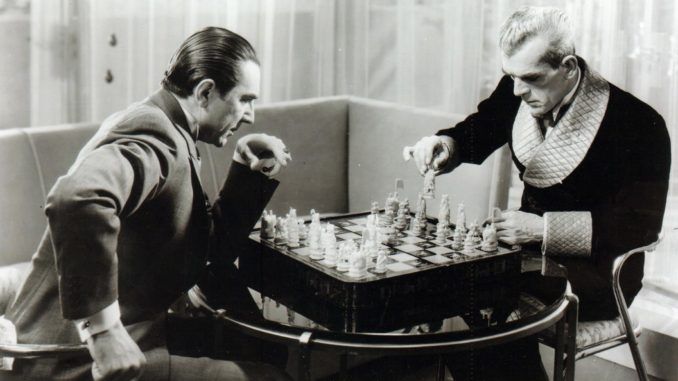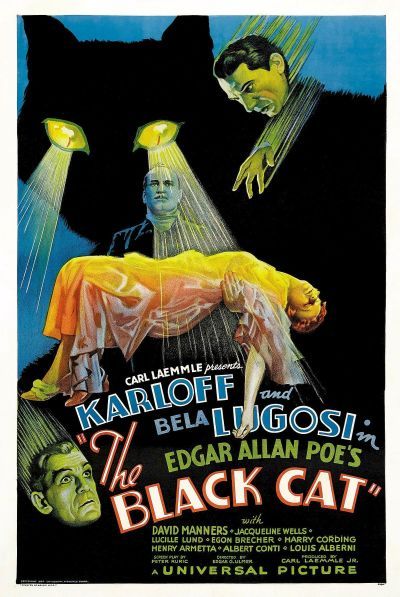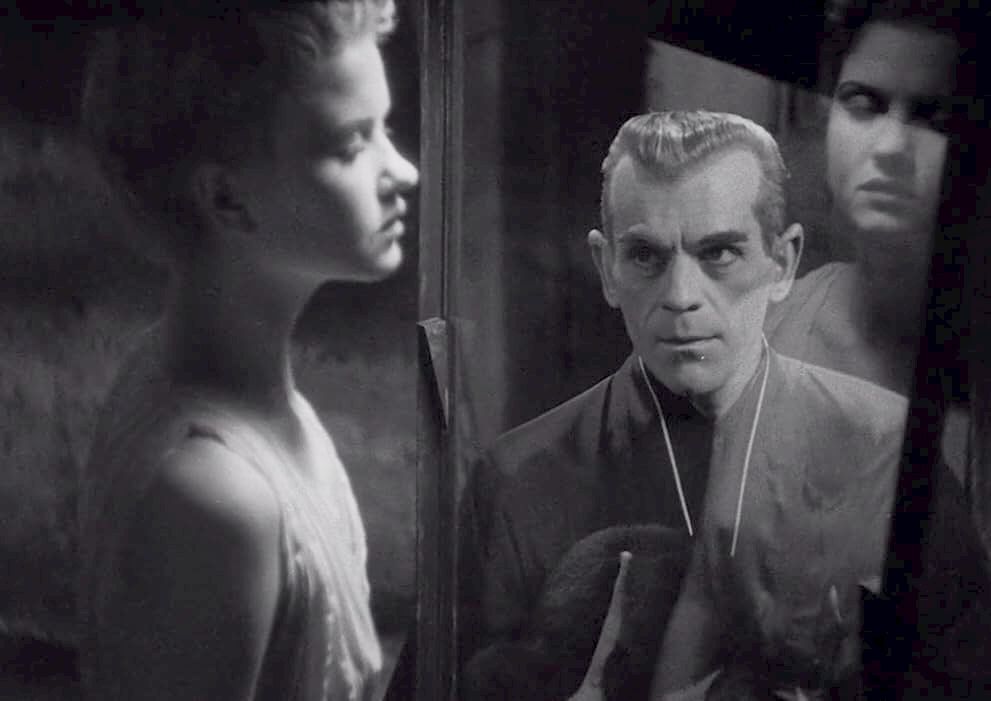
Rating: B-
Dir: Edgar G. Ulmer
Star: Boris Karloff, Bela Lugosi, David Manners, Julie Bishop
Only two films from this year reached the thousand vote quota on the IMDb, with this proving a runaway winner over Maniac, in both popularity (14K votes vs. 2.8K) and average rating (6.9 vs. 3.7). The latter is particularly rough: it’s the same rating, for example, as Cinderella’s Revenge. Which, in a weird coincidence, was published on this site the same day I watched The Black Cat. I will admit to liking the synopsis for Maniac: “A former vaudevillian gifted at impersonation assists a mad scientist in reanimating corpses and soon goes mad himself.” But it was directed by Dwain Esper, best known for Sex Madness, so I’m inclined to believe the low IMDb rating is not an unjust assessment.
There were a couple of interesting items below the thousand vote cut-off, which I will get round to watching outside this feature. The Ninth Guest has a 6.7 rating, almost as high as The Black Cat. , and has an appealing synopsis: “Eight people are invited to dinner. After they are wined and dined, a voice on the radio informs them that they will be murdered unless they manage to outwit the ninth guest: Death.” Ok, I’m sold. There’s also a Mexican film, Two Monks, which reportedly predates by sixteen years, the idea used in Rashomon of telling the same story from different viewpoints. It scores even higher, coming in at a 7.0. If there are general themes for the year, insanity and reviving the dead seem hot topics.
 This was probably the last horror film to be released widely before the enforcement of the Hays Code became obligatory. It first hit cinemas on May 7th, and less than two months later, on July 1st, the Production Code Administration was established. This was a department of the Motion Picture Producers and Distributors of America and had the full weight of the industry behind it. You could not show a film in an American cinema without a PCA certificate, with a potential fine of $25,000 – the equivalent of about $600,000 nowadays – for offenders. It effectively neutered the horror movie, and was likely a factor in the commercial and critical decline of the horror movie over the next decade and longer.
This was probably the last horror film to be released widely before the enforcement of the Hays Code became obligatory. It first hit cinemas on May 7th, and less than two months later, on July 1st, the Production Code Administration was established. This was a department of the Motion Picture Producers and Distributors of America and had the full weight of the industry behind it. You could not show a film in an American cinema without a PCA certificate, with a potential fine of $25,000 – the equivalent of about $600,000 nowadays – for offenders. It effectively neutered the horror movie, and was likely a factor in the commercial and critical decline of the horror movie over the next decade and longer.
This, however, was a hit, becoming Universal’s biggest movie of the year despite media disdain at the time, the New York Times calling the film, “more foolish than horrible. The story and dialogue pile the agony on too thick to give the audience a reasonable scare.” Regardless, the studio would go on to re-team Karloff with Lugosi on many more occasions, such as for another entry in this feature, Son of Frankenstein. Despite a credit claiming inspiration from the Edgar Allen Poe story of the same name, there’s no connection in terms of story. Though if you squint a little, the brooding atmosphere of barely suppressed madness certainly has something in common with the work of the Gothic writer. As does the importance of architecture, perhaps. Because the building here is a character as much as any Gothic castle.
It was built by famous architect Hjalmar Poelzig (Karloff), on the ruins of Fort Marmorus, which Poelzig commanded in the Great War. But he handed it over to the Russians, resulting in the death and capture of thousands of soldiers. One of them was Vitus Werdegast (Lugosi), who spend 15 years in a gulag as a result – his wife died while he was away, and his daughter ended up married to Poelzig, unaware of what he did. But Werdegast has now come calling, looking for retribution, and accompanied by two cheerfully unaware American newlyweds. They are writer Peter Alison (Manners) and his wife whom he introduces as “Mrs. Alison”, apparently not deserving a first name of her own. Hey, it was the thirties. [She is actually Joan, played by Bishop, though known at the time as Jacqueline Wells]
To be honest, that revenge-based plot would probably be enough. But, wait! There’s more! For Poelzig is actually the master of a black-magic cult, and has plans to… Well, it’s a little vague, but I’m going with sacrificing Joa… I mean Mrs. Alison, as part of an occult ritual. The character was reportedly based on Aleister Crowley – weirdly, the second time he has turned up in tangential connection to a film in this series. Poelzig is certainly creepy, though Werdegast is pretty damn weird as well, given his abject fear of cats, and stalkery obsession with Joan, due to a perceived resemblance she has to his long-lost wife.
 Indeed, deeper into the film than usual, I wasn’t quite sure who would be the villain. Neither Karloff nor Lugosi exactly had a glowing track record of playing characters you could trust, after all. If Bela asked to share my train carriage… yeah, I’d walk the rest of the way. However, eventually this becomes clear – reading a book called The Rites of Lucifer is probably a bit of a clue – and we can enjoy the struggle for power between these two titans of terror. It’s decent fun, though watching what can only be described as a Boris vs. Bela catfight was not impressive. It reminded me of the barely more geriatric fight at the end of Star Trek Generations, between William Shatner and Malcolm McDowell.
Indeed, deeper into the film than usual, I wasn’t quite sure who would be the villain. Neither Karloff nor Lugosi exactly had a glowing track record of playing characters you could trust, after all. If Bela asked to share my train carriage… yeah, I’d walk the rest of the way. However, eventually this becomes clear – reading a book called The Rites of Lucifer is probably a bit of a clue – and we can enjoy the struggle for power between these two titans of terror. It’s decent fun, though watching what can only be described as a Boris vs. Bela catfight was not impressive. It reminded me of the barely more geriatric fight at the end of Star Trek Generations, between William Shatner and Malcolm McDowell.
As noted, it does feel like the plot may throw too much in. For instance, Poelzig keeping the preserved corpses of women in his basement, in glass cases (above). That would be a topic sufficient for its own horror film, and the same goes for his Satanism of uncertain purpose. I liked the soundtrack, largely cobbled together from popular classical works by Chopin, Tchaikovsky, etc. Poelzig’s fate, while implied more than shown, is exactly the sort of thing the Hays Code would never permit. As such, this is a kind of horror movie whose like would not be seen on the screen again until the real world horrors of another World War had come and gone.
This article is part of our October 2025 feature, 31 Days of Vintage Horror.
